In an era where the world is grappling with the challenges of global warming and climate change, technology and innovation have become crucial tools for addressing these crises and fostering sustainability. CERT+, a startup under SCGC, has advanced the measurement of forest carbon credits and forest management through AI technology. By leveraging precise data, CERT+ contributes to continuous global warming mitigation while enhancing competitiveness in the global carbon credit market. This approach not only aligns with the needs of modern businesses that prioritize environmental responsibility but also supports sustainable growth within communities.
Although the average global temperature has not yet exceeded the critical threshold of 1.5 degrees Celsius set by the Paris Agreement, scientists warn that this level could make life on Earth increasingly difficult for all living beings. The 1.5-degree target represents a 20-year average, not just a single year's temperature. In response, countries worldwide have established goals to reduce greenhouse gas emissions through Nationally Determined Contributions (NDCs). They are accelerating the use of all available mechanisms and tools, including developing innovations, to mitigate or minimize the impacts of global warming and climate change as much as possible. With only a few years left to act, the urgency to adopt solutions like AI and forest carbon credits to foster sustainability has never been greater.
Forest Carbon Credits are a critical solution to help address the ongoing environmental crisis caused by global warming and climate change. At the same time, they offer a viable pathway for modern businesses striving to build a low-carbon society and achieve carbon neutrality. By integrating innovation and technologies like AI, forest carbon credits contribute to sustainability, aligning environmental responsibility with economic growth in today's evolving business landscape.
Forest carbon credits offer an innovative mechanism to combat greenhouse gas emissions by utilizing forests as natural carbon sinks. Through the process, trees absorb carbon dioxide (CO₂) from the atmosphere, which is then converted into tradable carbon credits within the carbon market. Here's how forest carbon credits work:
- Reforestation and Forest Restoration: Planting or restoring forests allows trees to absorb CO₂, significantly reducing greenhouse gas levels.
- Carbon Measurement: The amount of carbon stored is calculated using globally recognized standards, such as the Verified Carbon Standard (VCS) or Gold Standard.
- Issuing Carbon Credits: These credits are then sold to businesses aiming to offset their carbon footprint.
To incentivize businesses and industries to reduce carbon emissions, drive the green economy, and achieve Net Zero goals, carbon pricing mechanisms have been introduced. These tools assign a cost or price to carbon emissions, encouraging reductions in greenhouse gas outputs. One such mechanism is the Carbon Tax, which sets a tax rate per unit of carbon emissions. This may be levied directly on emission sources (Emission Tax) or on resource usage, such as taxing the carbon content in fuels. Additionally, Carbon Trading Markets play a significant role globally, allowing businesses to trade carbon credits as part of their emission reduction strategies. These mechanisms not only motivate emission reductions but also help align economic activities with sustainability goals, fostering a transition toward a low-carbon future.

Carbon Credits refer to the amount of greenhouse gases that can be reduced or captured through projects aimed at reducing emissions, compared to the baseline scenario of normal business operations (Business-as-Usual: BAU). Measured in metric tons of carbon dioxide equivalent (tCO2eq), these credits must be certified according to established standards and can be traded between entities seeking to offset their carbon emissions and those actively reducing them. In Thailand, carbon credits must be certified by the Thailand Greenhouse Gas Management Organization (Public Organization) or TGO, which oversees the T-VER (Thailand Voluntary Emission Reduction Program) mechanism. This program incentivizes various sectors to reduce their carbon emissions and contribute to sustainability. Carbon credits are primarily derived from two types of projects: 1. Emission reduction/avoidance: Examples include adopting renewable energy, improving energy efficiency, and waste management.; 2. Removal or Nature-based sequestration: This includes technologies like carbon capture and storage or reforestation efforts, such as using forest carbon credits to absorb greenhouse gases. The amount of greenhouse gases reduced or removed through these projects must be certified and registered as carbon credits before they can be traded. Entities that reduce emissions (Supply) can sell these credits to those seeking to offset their emissions (Demand). By integrating AI and innovation, projects like these not only address global warming and climate change but also pave the way for a more sustainable future.
Taken this context, carbon credits can be seen as a reward for businesses that actively reduce or prevent the release of greenhouse gases into the atmosphere—one of the root causes of today's pressing issues like climate change and global warming. This concept has evolved to include the use of forests as a natural-based solution to absorb carbon emissions. According to the World Economic Forum, forest carbon credits are more popular than traditional carbon credit projects due to their proven ability to effectively reduce and sequester greenhouse gases. At the same time, they provide significant economic benefits to local communities, making them a powerful tool for fostering sustainability. Forest carbon credits represent a vital pathway toward building a low-carbon society, achieving carbon neutrality, and ultimately reaching net zero emissions, where the net release of greenhouse gases is reduced to zero. By integrating innovation and technologies like AI, these solutions offer both environmental and economic advantages, addressing global challenges while promoting sustainable development.
Kasikorn Research Center forecasts that during 2024-2025, forest carbon credits in Thailand have the potential to be certified at approximately 600,000–700,000 tCO2eq, representing a fivefold increase compared to the total amount previously certified in the past.
Currently, the Thailand Greenhouse Gas Management Organization (Public Organization) or TGO serves as the primary agency responsible for certifying carbon credits in Thailand. TGO has established regulations for projects related to the reduction, absorption, and sequestration of greenhouse gases from the forestry and agricultural sectors. Each method has specific requirements and details, so project developers should carefully select the approach that best aligns with their goals and needs for successful implementation.
AI, or Artificial Intelligence, is a groundbreaking technology that has gained immense importance and popularity in today's world. This modern innovation is designed to mimic human cognitive abilities through learning and data processing, enabling AI to analyze information and make decisions with high efficiency. Its applications span across various fields, including the monitoring and enhancement of green spaces. By integrating AI into these efforts, it optimizes land use, supports the development of forest carbon credits, and generates economic opportunities for communities. This approach not only addresses challenges like climate change and global warming but also promotes sustainability through innovative solutions.

One of the key roles of AI is in the assessment of forest carbon credits, where it helps measure the amount of carbon stored in trees and forested areas using remote sensing technology. With AI as a central tool, remote sensing via satellites, airplanes, or drones enables precise and comprehensive analysis of the physical characteristics of forest areas, even across large-scale regions. Data derived from this process, such as land use changes, forest cover, and forest health, facilitates faster and more cost-effective environmental monitoring compared to traditional ground inspections. By leveraging AI for carbon credit evaluation and green space development, this technology not only aids in reducing greenhouse gas emissions but also strengthens sustainability efforts and provides a tangible response to the challenges of climate change and global warming. This innovative approach ensures a more efficient path toward environmental preservation and sustainable development.
SCGC, a leading integrated polymer business and comprehensive solutions provider for sustainability, is committed to achieving carbon neutrality through innovation and cutting-edge technologies. A key focus is the efficient measurement of forest carbon credits and sustainable forest management. This is achieved through CERT+, a startup under SCGC, which utilizes remote sensing technology and AI (Artificial Intelligence) to accurately assess carbon credits from forested areas. By integrating these advanced tools, SCGC not only addresses climate change and global warming but also contributes to long-term sustainability with innovative solutions.
CERT+ technology can transform 2D images captured by satellites, airplanes, or drones into 3D data, such as the width and height of trees. This enables precise and near real-time calculations of the carbon stored in trees. CERT+ has been officially certified by the Thailand Greenhouse Gas Management Organization (Public Organization) or TGO, the country's authority for carbon credit certification, for its methodology in assessing carbon sequestration.

The data generated by this technology can be utilized in various ways, such as trading or exchanging forest carbon credits in carbon markets, offsetting greenhouse gas emissions from organizations, individuals, or products, and reporting environmental outcomes. CERT+ enhances forest management for carbon credit purposes through two innovative services. The first is a monitoring and tracking system, which calculates tree growth, wood volume, and stored carbon while forecasting future yields. The second is an alert system that detects changes in forest areas, such as the disappearance of plant species or risks of wildfires. By integrating AI and cutting-edge innovation, CERT+ contributes to addressing climate change and global warming, advancing sustainability through efficient and data-driven solutions.
CERT+ is now compatible with various plant species, including eucalyptus, teak, and natural forests, with eucalyptus being specifically certified by the Thailand Greenhouse Gas Management Organization (TGO). This certification covers key species in Thailand and the Asia-Pacific region. Aligned with SCGC's commitment to the Low Waste, Low Carbon approach, CERT+ serves as a prime example of a business leveraging innovation and technology to promote sustainability. Its solutions focus on efficient natural resource management, minimizing environmental impacts, and incentivizing tree planting for forest carbon credits. By addressing climate change and global warming, CERT+ supports the development of a future low-carbon society, paving the way for a more sustainable world.
------------------------------------------------------------------------------------
References and Image Credits:
- https://www.unep.org/topics/climate-action/climate-finance/carbon-markets
- https://unfccc.int/climate-action/united-nations-carbon-offset-platform
- https://www.investopedia.com/terms/c/carbon_credit.asp
- https://www.krungsri.com/en/research/research-intelligence/carbon-credit-2023
- https://www.smethailandclub.com/entrepreneur/9561.html
- https://media.licdn.com/dms/image/v2/C4E12AQEi4l-2x1gEHw/article-cover_image-shrink_720_1280/article-cover_image-shrink_720_1280/0/1642398885971?e=2147483647&v=beta&t=xJgz0kYw3AIlE_CK69VXynxF7GhIXnT8unZLRho_nMc
- https://media.licdn.com/dms/image/v2/D4E12AQEG91lyEUMoIw/article-cover_image-shrink_600_2000/article-cover_image-shrink_600_2000/0/1718806337570?e=2147483647&v=beta&t=mrq4GmjPUPRahvLTGq7YkadfBrad-WBr3dN9oHm_NLI








